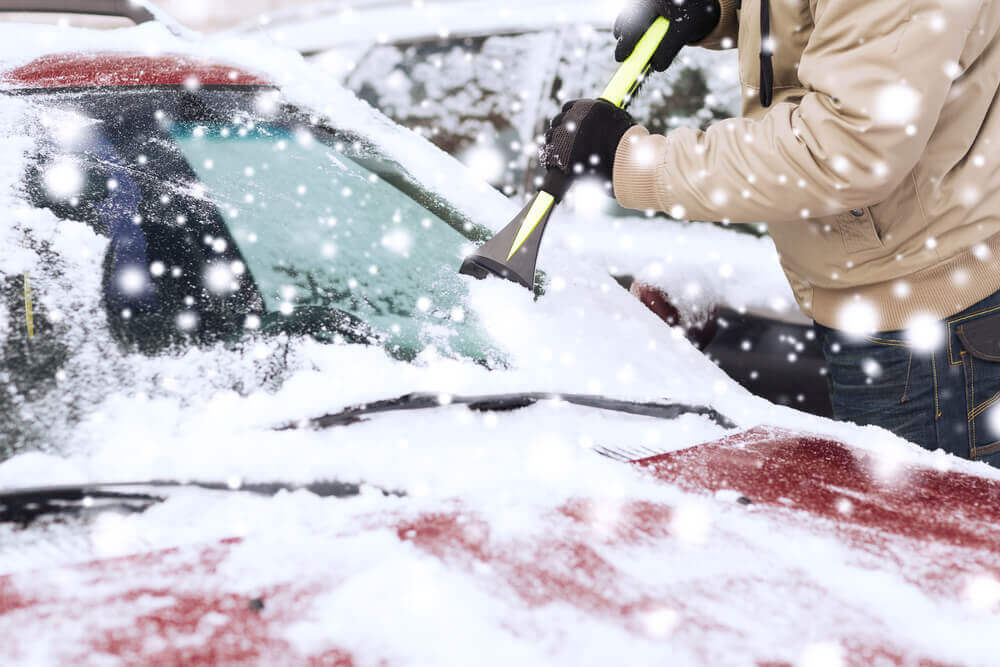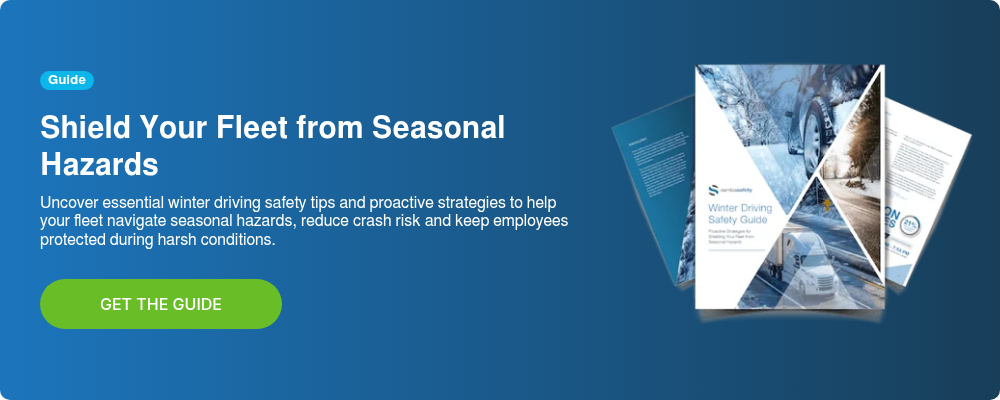
Winter weather presents a huge risk to fleet safety, creating added dangers and stress for employee drivers. This alongside the rise in risky driving behavior year after year creates a greater potential for employee-involved crashes. With this in mind, we’ve provided winter driving safety tips for employees to ensure they are properly prepared every time they get behind the wheel.
We’ve also included strategies for risk and safety managers to help you proactively manage driver risk throughout the dangerous winter season and beyond.
Below, we cover:
- Troubling Winter Driving Statistics
- OSHA Winter Driving Tips
- 5 Winter Driving Safety Tips for Employees
- 4 Winter Driving Safety Strategies for Risk Managers
- More Winter Driving Safety Resources
Troubling Winter Driving Statistics
Did you know..?

While these statistics may be troublesome, there are proactive measures companies and their drivers can take to increase preparedness, protect themselves and prevent crashes.
OSHA Winter Driving Tips
OSHA, or the Occupational Safety and Health Administration, ensures that employers fulfill their responsibility of providing a safe workplace. Its overall mission is to ensure safe and healthful working conditions for workers. OSHA enforces this by setting and enforcing standards and by providing training, outreach, education and assistance.
OSHA has established winter driving tips to help prepare and protect those behind the wheel. The administration refers to these as the “Three P’s of Safe Winter Driving”:
- PREPARE for the trip – this includes proactively preparing both the vehicle and the driver for winter weather conditions
- PROTECT yourself – ensuring drivers are properly buckled in, securing passengers, etc.
- PREVENT crashes on the road – this includes driving defensively, getting proper rest and ensuring you are fully alert before getting behind the wheel
In light of these steps, we’ve gathered important winter driving safety tips for employees and risk managers to ensure your fleet is well-prepared to handle the dangers of the road each winter season.
5 Winter Driving Safety Tips for Employees
1. Inspect Your Vehicle Daily
- Fuel – Fuel up at the end of the day and don’t let your vehicle drop below a quarter of a tank.
- Weather – Review the forecast throughout the day, as conditions may change.
- Lights – Clear ice and snow from tail lights, reflectors, marker lights and headlights as needed throughout the day.
- Tires – Confirm tires are filled to the correct pressure level and have adequate tread for winter driving.
- Fluid Levels – Check antifreeze and windshield wiper fluid levels.
- Defroster – Ensure proper ventilation and keep your dashboard clear of paperwork and other items that can block airflow.
- Exhaust System – Inspect for leaks, as carbon monoxide poisoning can be deadly.
- Yourself – Acknowledge when you’re not at your best and take extra precautions.
2. Practice Cold Weather Driving
During the daytime, it can give drivers a better idea of the conditions they will be facing if they rehearse common maneuvers slowly on ice or snow in an empty lot. This includes:
- Understanding how the brakes operate (stomping on antilock brakes, pumping on non-antilock breaks, etc.)
- Testing how long it takes to slow down
- Practicing steering into a skid
3. Plan Trips Thoroughly
Your drivers need to have a plan anytime they get behind the wheel. They need to know where they are going, how they are going to get there and if they have enough fuel and time to do so. Employees should also allow plenty of time (check the weather and leave early if necessary) to become familiar with the directions and let others know their route and arrival time.
4. Maintain Good Space Management
Managing the space around a driver’s vehicle is critical. Drivers must be aware of how much space they need between other vehicles and potential hazards. This helps them properly adjust to traffic, change or merge lanes, cross intersections, manage blind spots, etc. in bad weather.
5. Avoid Fatigue
Drivers tend to underestimate the dangers of drowsy driving. Did you know?
- Drivers who have slept fewer than five hours have the same crash risk as a drunk driver
- Drowsy driving is a factor in at least 20% of fatal crashes
Things becomes even more dangerous as drivers navigate the snow, ice and other dangerous conditions. This paired with long hours and increased traffic due to the holidays can easily cause driver fatigue and burnout.
It’s critical for drivers to get the rest they need, take all mandated breaks and refrain from operating the vehicle if they do not feel alert enough to make the right decisions.
4 Winter Driving Safety Strategies for Risk Managers
While it’s critical for employees to properly prepare themselves each and every time they get behind the wheel, it’s also your responsibility to ensure that they have all the tools, resources and support needed to maintain success in their role. We explore four critical strategies you can implement to better prioritize fleet safety.
1. Ensure All Company Vehicles and Drivers Are Prepared for the Winter Weather
Fleet managers must ensure that vehicles are properly serviced and maintained before hitting the road during the winter season. This includes routine maintenance and checking for any manufacturer recalls.
The mechanic should be paying close attention to:
- Car batteries
- Windshield wipers
- Lights
- Cooling systems
- Tire treads
Beyond vehicle maintenance, employees must also ensure they have the necessary supplies in case of an emergency. This can include:
- Flashlights
- Cell phone and charger
- Jumper cables
- Abrasive materials (sand, kitty litter,floor mats)
- Chains
- Shovels, snow brushes and ice scrapers
- Warning devices (like flares)
- Blankets
- Food and water, medication (for longer trips)
2. Assign Fleet Driver Training Year-Round
Driver training needs to be a year-round, ongoing commitment – regardless of a driver’s level of experience, tenure or past driving history. Every driver benefits from constant refreshers. It ensures safety is top-of-mind at all times, instilling greater confidence behind the wheel and increasing driver satisfaction in their role.
Did you know? Fleets that train on a monthly basis have 50% fewer violations than those that train twice a year.
But with so much to cover, where do you start? You may want to consider establishing a year-long training program, or scheduling courses covering distracted driving, defensive driving and specific courses catered to winter driving safety training.
Distracted Driving Training
Distracted driving is a year-round issue, but the dangers of driving while distracted escalate during the winter months. If your driver is traveling at a speed of 60 mph, their vehicle travels more than the length of an Olympic-sized swimming pool every two seconds. Taking a quick glance away from the road to check a text message, adjust a mirror, check the GPS or grab something from below can cause a major incident at that distance.
Causes of distracted driving can include:
- Cell phone use
- Rubbernecking
- Eating, drinking or smoking
- Adjusting or reaching
- Fatigue
- Passengers
How do safety managers reduce distracted driving across their fleet?
To start, make sure that you clearly state your company’s stance on distracted driving in your driver safety policy. This must include your policies on cell phone usage, smoking, etc. Your policy should set forth your company rules surrounding driver safety, driver responsibilities and the consequences of engaging in dangerous behaviors like distracted driving.
Next, it’s critical to provide fleet distracted driving training, both proactively and as a remediation tool to correct poor driving behavior. This should cover the nature of distractions, their impact and how simple practices can help your employee drivers avoid them.
Unsure where to start or what to include? Explore these distracted driving training courses.
Defensive Driver Training
So much of your drivers’ success behind the wheel depends on their ability to defend themselves and their vehicles from external factors. The ability to make the right decisions at the right time is critical in preventing incidents on the road. Fleet defensive driving training is another aspect of your fleet training program that can and should be covered year-round.
These ongoing courses should cover:
- Distractions
- Effective communication
- Fatigue management
- Evaluating space
- Navigating hazards
- Speed management
- Essential planning
These skills are critical, especially throughout the winter months as the roads become harder to navigate, with more traffic and hazards on the road, risky weather conditions, heightened driver fatigue and potential burnout. It’s your job to ensure that defensive driving skills are second nature to your drivers.
Winter Driving Safety Training
Your drivers must also know how to prepare for and avoid driving hazards that are common throughout the winter months. Investing in winter driving safety training will help prevent winter-related incidents and ensure your drivers are ready to navigate the heightened dangers of the road.
These courses should include:
- Avoiding roadside collisions
- Fatigue management
- Installing tire chains
- Night driving
- Rear-end collision avoidance
- Skid control
- Winter driving (with and without chains)
3. Have the Right Level of Visibility into Your Drivers’ Behavior
Implementing the right driver training program is critical in making sure your drivers are properly equipped with the knowledge and skills they need. But you must also have the right level of visibility in place to ensure that they are making the right choices once they actually get behind the wheel. If they aren’t, you likely need a more targeted training approach to remediate poor driving behavior.
The right level of visibility requires more than annual MVR pulls or asking employees to self-report when they receive a violation. Risk managers need to establish a process that provides them with the complete picture of their driver risk, with ongoing insights into all data sources: MVR and CSA data, crashes and claims, which should be layered with any existing telematics, camera and ELD data.
This full understanding of violations, current license statuses, compliance and real-time driver behavior gives risk managers the 360-degree view needed to understand each driver’s potential risk and take the appropriate action to mitigate it.
4. Provide Ongoing Communication and Safety Reminders
Establishing a strong culture of safety across your fleet requires more than just setting and forgetting your driver training program. Safety reminders and the ongoing communication of company policies surrounding safety are critical, especially during the winter months.
You can better communicate safety to your drivers by:
- Sending out daily or weekly safety tips via text or email
- Asking supervisors to share a safety tip at every driver briefing
- Hanging a winter driving safety poster in the break room or around the office
- Publicly recognizing employees who are prioritizing safety and displayed good driving behaviors
Your goal here is to help keep safety top-of-mind and ensure that your drivers understand how much your company prioritizes safety and their well-being.
More Winter Driving Safety Tips
We realize we’ve covered a lot of ground here, and we want to ensure you have the support needed to establish a comprehensive winter driving safety program that you feel confident in.
We’ve bundled together our best winter driving safety tips and strategies into a comprehensive guide. Visit the link below to download your free copy and learn how to better protect your fleet from the heightened hazards of winter!




